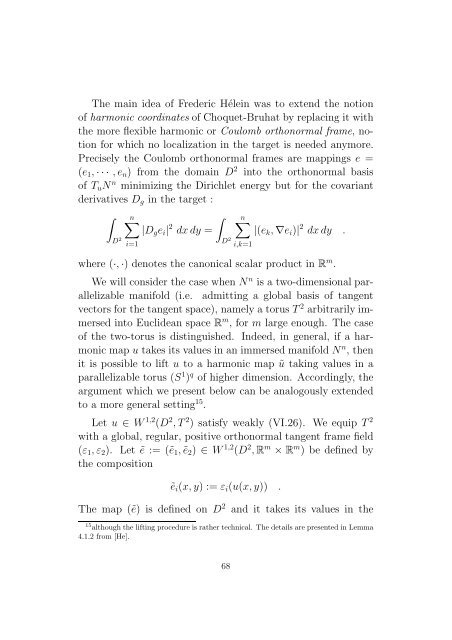Conformally Invariant Variational Problems. - SAM
Conformally Invariant Variational Problems. - SAM
Conformally Invariant Variational Problems. - SAM
Create successful ePaper yourself
Turn your PDF publications into a flip-book with our unique Google optimized e-Paper software.
The main idea of Frederic Hélein was to extend the notion<br />
of harmonic coordinates of Choquet-Bruhat by replacing it with<br />
the more flexible harmonic or Coulomb orthonormal frame, notion<br />
for which no localization in the target is needed anymore.<br />
Precisely the Coulomb orthonormal frames are mappings e =<br />
(e 1 ,··· ,e n ) from the domain D 2 into the orthonormal basis<br />
of T u N n minimizing the Dirichlet energy but for the covariant<br />
derivatives D g in the target :<br />
∫<br />
D 2<br />
n∑<br />
∫<br />
|D g e i | 2 dxdy =<br />
i=1<br />
D 2<br />
n∑<br />
|(e k ,∇e i )| 2 dxdy .<br />
i,k=1<br />
where (·,·) denotes the canonical scalar product in R m .<br />
We will consider the case when N n is a two-dimensional parallelizable<br />
manifold (i.e. admitting a global basis of tangent<br />
vectors for the tangent space), namely a torus T 2 arbitrarilyimmersed<br />
into Euclidean space R m , for m large enough. The case<br />
of the two-torus is distinguished. Indeed, in general, if a harmonic<br />
map u takes its values in an immersed manifold N n , then<br />
it is possible to lift u to a harmonic map ũ taking values in a<br />
parallelizable torus (S 1 ) q of higher dimension. Accordingly, the<br />
argument which we present below can be analogously extended<br />
to a more general setting 15 .<br />
Let u ∈ W 1,2 (D 2 ,T 2 ) satisfy weakly (VI.26). We equip T 2<br />
with a global, regular, positive orthonormal tangent frame field<br />
(ε 1 ,ε 2 ). Let ẽ := (ẽ 1 ,ẽ 2 ) ∈ W 1,2 (D 2 ,R m × R m ) be defined by<br />
the composition<br />
ẽ i (x,y) := ε i (u(x,y)) .<br />
The map (ẽ) is defined on D 2 and it takes its values in the<br />
15 although the lifting procedure is rather technical. The details are presented in Lemma<br />
4.1.2 from [He].<br />
68
















